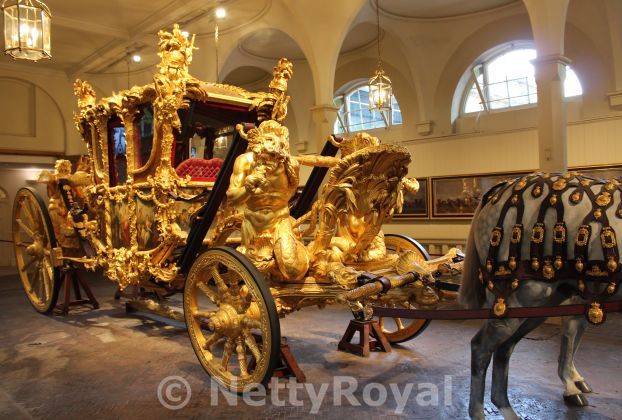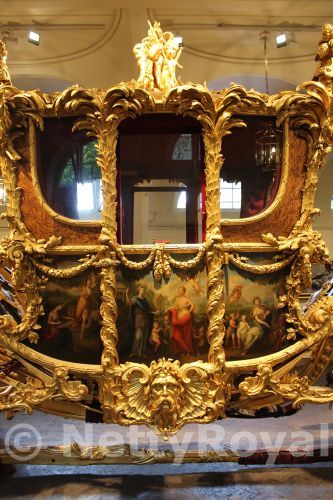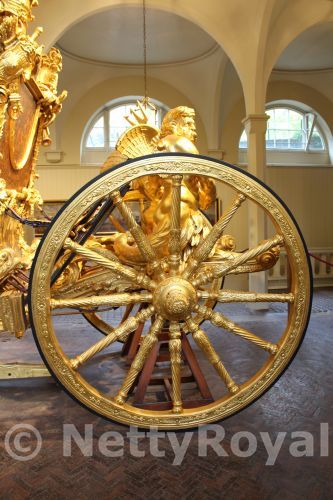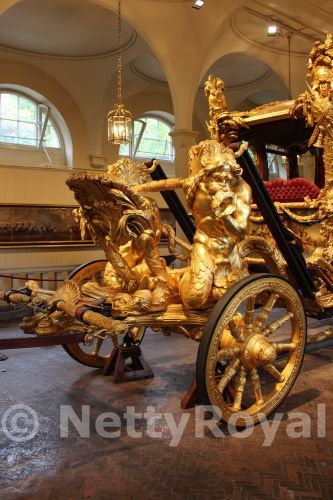Although I have visited London several times over the years, I had never been to the Royal Mews. I can only say: if you have time, just go there. I visited on a very quiet Monday afternoon in May 2017 and really loved my visit. Not a lot of visitors around, so I had all the time to look around. The most amazing coach in the possession of the British royal family is the Gold State Coach. As a visitor you can get unbelievably close and have a look at all the details. I can’t imagine anybody creating such a lavish and pompous coach anymore these days.




The coach can be seen in its very own hall. It was commissioned in 1760 by The King’s Master of the Horse, Francis Hastings, 10th Earl of Huntingdon. It was designed by architect Sir William Chambers and built in the workshops of Samuel Butler in London. At the time it costed £7,562, which would nowadays be an amazing amount of around £1,8 Million. It was intended to be used at the coronation of King George III and his wedding to Princess Charlotte of Mecklenburg-Strelitz in 1761. However it was such a big project to make the coach, that it was only used for the first time for the State Opening of Parliament in November 1762. The coach has been used at every coronation since 1821, when King George IV was crowned. The age, weight and size make that it is only used at grand state occasions like coronations, royal weddings or jubilees of a monarch. The last time the coach was used in public was at the Golden Jubilee of Queen Elizabeth II in 2002.
The coach weighs four tons, is 7,3 metres long, 2,4 metres wide and 3,7 metres high. It is being drawn by eight Windsor Grey horses wearing red Morocco leather harness. The panels were painted by Giovanni Battista Cipriani. They of course represent Great Britain as a great nation with an impressive naval and military history. The scene on the front shows Victory presenting laurels to Britannia. On the side the panels show classical Greek and Roman figures. The back panels shows Neptune and Amphitrite arriving at the shores of Great Britain.



The richly gilded carved sculpture was done by carver Joseph Wilton, gilder Henry Pujolas and metal chaser George Coyte. On the roof of the carriage you will find three cherubs representing England, Scotland and Ireland, carrying the Imperial Crown and hold the sword, sceptre and the badge representing Knighthood. The roof is being framed with eight palm trees, four of them rising from a Lion’s head. The leather straps supporting the body of the coach are being held by four Tritons (mythical sea-gods) with a man’s head and a dolphin’s tail. The two Tritons at the front herald the arrival of the Monarch of the Ocean. The two at the back carry imperial symbols, representing the maritime traditions of Great Britain.
When being used, apart from the coachman, the coach is being accompanied by four postilions, 9 walking grooms (one of them walks behind the coach), 6 footmen and 4 Yeoman of the Guard. It seems it is not really a delight to be driven in this coach, that can only be pulled at a walk. Even marine man King William IV complained that it was like travelling in a rough ship at sea. And King George VI had the iron-bound wheels rubberised to make it more comfortable.
